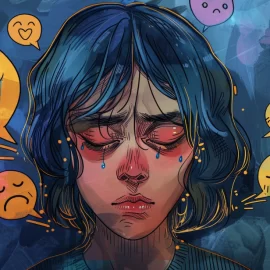

This article is an excerpt from the Shortform book guide to "Humankind" by Rutger Bregman. Shortform has the world's best summaries and analyses of books you should be reading.
Like this article? Sign up for a free trial here .
If humans are cooperative by nature, why do we wage wars with each other? Does our species owe its survival to competition or to cooperation?
According to Rutger Bregman, the author of Humankind, human cooperation is the reason our species survived. Based on archaeological evidence, he concludes that early humans were compassionate and cooperative. He argues that, contrary to popular belief, they didn’t engage in war with each other.
Here’s why humans are cooperative—rather than competitive—by nature, according to Bregman.
Early Human Foragers Avoided War
According to Bregman, early human foraging groups lived peacefully and cooperatively with each other for millions of years. It was human cooperation that helped groups survive in the face of harsh weather conditions and predators, and the evidence suggests that they didn’t go to war against each other.
Bregman explains that when scientists first discovered the bones of early humans, they theorized that our ancestors were brutal killers and cannibals. In the 1920s, anatomist Raymond Dart studied the skull of an Australopithecus africanus, a human ancestor that lived 2 to 3 million years ago. Based on the skull’s injuries, Dart concluded that these early humans violently murdered one another. He published his theory in the 1950s, calling it “Killer Ape Theory.”
(Shortform note: While Bregman focuses on the development of Killer Ape Theory, Dart’s study of the skeletal remains of Australopithecus africanus also resulted in another important finding: that humans originated in Africa. Charles Darwin had proposed that Africa was the birthplace of humanity in his 1871 book The Descent of Man. But by the 1920s, most theories suggested that the first humans lived in Eurasia, based on skeletal remains found in France and England. Dart suggested that Australopithecus africanus, discovered in South Africa, predated these remains. While his theory was dismissed at the time, later findings confirmed that he was right.)
However, Bregman notes that more recent studies have debunked Killer Ape Theory and revealed that our ancestors were peaceful. In 2006, archaeologists examined the same Australopithecus africanus skull that Dart had studied in the 1920s. They found that the injuries came from a large predatory bird, not from other early humans. Skeletal remains from later in history tell a similar story: According to Bregman, not a single archaeological site suggests that early human foragers fought against each other
Humans Have Survived by Cooperating and Learning
Bregman argues that humans have survived—and thrived—not because of our cruelty or ability to wage war, but because of our capacity for social learning. Social learning is our ability to gain skills and knowledge from those around us through observation and imitation.
According to Bregman, social learning allowed humans to survive because it made us smarter as a species. Evidence suggests that individually, our early human ancestors weren’t as smart or as strong as other species, such as the Neanderthals (Homo neanderthalensis)—another species of early humans that died out about 40,000 years ago. Bregman notes that Neanderthals had bigger brains and a stronger build than our species (Homo sapiens).
If, as Bregman claims, Neanderthals were stronger and smarter, then why did they go extinct while Homo sapiens survived? Bregman explains that social learning allowed early humans to accumulate knowledge and technology—such as tools—more efficiently than other species. Individual Neanderthals and other animals may have been smarter and stronger than individual Homo sapiens. But we were master imitators: Once one Homo sapien developed a tool, she could share it with more connections than Neanderthals could, creating a larger web of knowledge. This ability to share knowledge made our collective species more technologically advanced than the Neanderthals.
In addition to providing a technological advantage, humans’ knack for social learning also helped us survive a changing climate. According to Bregman, one theory suggests that Neanderthals died out because they couldn’t adapt to extreme swings in temperature. On the other hand, humans were able to work together to adapt and survive.
Bregman explains that as humans evolved, we became biologically hardwired to learn from each other. Studies of human skulls suggest that over hundreds of thousands of years, our ancestors’ faces became less threatening and easier to read. Unique among primates, we developed white parts of our eyes, which allowed us to track each others’ gazes. We have less severe and more expressive brows than other species. These physical changes made it easier for us to read each other’s expressions, develop trust, and share knowledge through nonverbal communication.
Shortform Commentary: Fact Checking Bregman’s Claims About Neanderthals
In the previous section, Bregman claims that Neanderthals were stronger and smarter than Homo sapiens, but that humans survived because we were better at learning. However, he leaves out some important nuances. Let’s explore what other researchers have to say about the differences between Homo sapiens and Neanderthals, and why the latter went extinct while the former survived.
Other research largely aligns with Bregman’s claims that Neanderthals were stronger than Homo sapiens. Archaeological evidence suggests that Neanderthals had a lower center of gravity and bigger muscles, especially in the arms, back, and chest, than Homo sapiens. However, while Neanderthals may have been more powerfully built, evidence suggests that humans were better at long-distance running.
In terms of intelligence, the story is more complicated. While scientists have found that Neanderthals had bigger brains than Homo sapiens, many note that Neanderthals weren’t necessarily more intelligent. Neanderthals’ brains were only slightly bigger than ours, but they were also longer. This likely means that their brains worked differently than ours because certain areas were larger or smaller. Because we can’t see an actual Neanderthal brain, it’s hard to know how the two species compared in terms of intelligence.
Lastly, let’s examine Bregman’s claim that the Neanderthals died out because humans were better at social learning, which allowed us to share technology and survive extreme swings in climate conditions. Scientists note that we still don’t know why Neanderthals went extinct. However, most theories align with Bregman’s emphasis on social connections and a changing climate. For example, one theory suggests that Homo sapiens had larger trading networks than Neanderthals, which allowed them to get food from other places in times of climate-induced famine.

———End of Preview———
Like what you just read? Read the rest of the world's best book summary and analysis of Rutger Bregman's "Humankind" at Shortform .
Here's what you'll find in our full Humankind summary :
- Why humans are fundamentally good, not evil
- How the Stanford Prison Experiment was misleading
- How recent studies have debunked "Killer Ape Theory"






